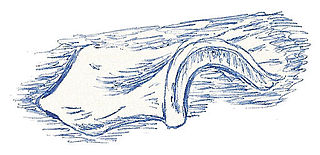
Iliosuchus is a genus of theropod dinosaur known from Bathonian–age rocks of England. It was perhaps 2 metres (6.6 ft) long.
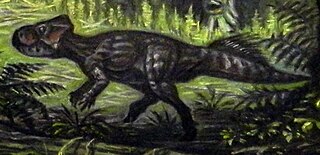
Microceratus is a genus of small ceratopsian dinosaur that lived in the Cretaceous period in Asia. It walked on two legs, had short front arms, a characteristic ceratopsian frill and beak-like mouth, and was around 60 cm (2.0 ft) long. It was one of the first ceratopsians, or horned dinosaurs, along with Psittacosaurus in Mongolia.

Metriacanthosaurus is a genus of metriacanthosaurid dinosaur from the upper Oxford Clay of England, dating to the Late Jurassic period, about 160 million years ago.
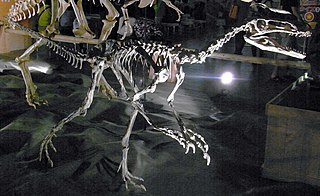
Guanlong (冠龍) is a genus of extinct proceratosaurid tyrannosauroid dinosaur from the Late Jurassic of China. The taxon was first described in 2006 by Xu Xing et al., who found it to represent a new taxon related to Tyrannosaurus. The name is derived from Chinese, translating as "crown dragon". Two individuals are currently known, a partially complete adult and a nearly complete juvenile. These specimens come from the Oxfordian stage of the Chinese Shishugou Formation.

Paranthodon is a genus of stegosaurian dinosaur that lived in what is now South Africa during the Early Cretaceous, between 139 and 131 million years ago. Discovered in 1845, it was one of the first stegosaurians found. Its only remains, a partial skull, isolated teeth, and fragments of vertebrae, were found in the Kirkwood Formation. British paleontologist Richard Owen initially identified the fragments as those of the pareiasaur Anthodon. After remaining untouched for years in the British Museum of Natural History, the partial skull was identified by South African paleontologist Robert Broom as belonging to a different genus; he named the specimen Palaeoscincus africanus. Several years later, Hungarian paleontologist Franz Nopcsa, unaware of Broom's new name, similarly concluded that it represented a new taxon, and named it Paranthodon owenii. Since Nopcsa's species name was assigned after Broom's, and Broom did not assign a new genus, both names are now synonyms of the current binomial, Paranthodon africanus. The genus name combines the Ancient Greek para (near) with the genus name Anthodon, to represent the initial referral of the remains.

Futalognkosaurus is a genus of titanosaurian dinosaur. The herbivorous Futalognkosaurus lived approximately 87 million years ago in the Portezuelo Formation, in what is now Argentina, of the Coniacian stage of the late Cretaceous Period. The fish and fossilized leaf debris on the site, together with other dinosaur remains, suggest a warm tropical climate in Patagonia during this period.

Lambeosaurinae is a group of crested hadrosaurid dinosaurs.
Thomas Richard Holtz Jr. is an American vertebrate palaeontologist, author, and principal lecturer at the University of Maryland's Department of Geology. He has published extensively on the phylogeny, morphology, ecomorphology, and locomotion of terrestrial predators, especially on tyrannosaurids and other theropod dinosaurs. He wrote the book Dinosaurs and is the author or co-author of the chapters "Saurischia", "Basal Tetanurae", and "Tyrannosauroidea" in the second edition of The Dinosauria. He has also been consulted as a scientific advisor for the Walking with Dinosaurs BBC series as well as the Discovery special When Dinosaurs Roamed America, and has appeared in numerous documentaries focused on prehistoric life, such as Jurassic Fight Club on History and Monsters Resurrected, Dinosaur Revolution and Clash of the Dinosaurs on Discovery.

Cetiosauridae is a family of sauropod dinosaurs which was first proposed by Richard Lydekker in 1888. While traditionally a wastebasket taxon containing various unrelated species, some recent studies have found that it may represent a natural clade. Alongside Cetiosaurus from the Middle Jurassic of Britain, other taxa recently assigned to the family include Lapparentosaurus from the Middle Jurassic of Madagascar, and Patagosaurus from the late Early-Middle Jurassic of Patagonia, which share autapomorphies with Cetiosaurus that are not shared by other eusauropods. Additionally, at least one study has suggested that the mamenchisaurids may represent a sub-group of the cetiosaurids, which would be termed Mamenchisaurinae.
Gobipterygidae is a family of extinct enantiornithine birds known from the Cretaceous of Asia.

Suchosaurus is a spinosaurid dinosaur from Cretaceous England and Portugal, originally believed to be a genus of crocodile. The type material, consisting of teeth, was used by British palaeontologist Richard Owen to name the species S. cultridens in 1841. Later in 1897, French palaeontologist Henri-Émile Sauvage named a second species, S. girardi, based on two fragments from the mandible and one tooth discovered in Portugal. Suchosaurus is possibly a senior synonym of the contemporary spinosaurid Baryonyx, but is usually considered a dubious name due to the paucity of its remains, and is considered an indeterminate baryonychine. In the Wadhurst Clay Formation of what is now southern England, Suchosaurus lived alongside other dinosaurs, as well as plesiosaurs, mammals, and crocodyliforms.
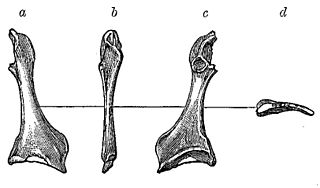
Cimolopteryx is a prehistoric bird genus from the Late Cretaceous Period. It is currently thought to contain only a single species, Cimolopteryx rara. The only specimen confidently attributed to C. rara was found in the Lance Formation of Wyoming, dating to the end of the Maastrichtian age, which ended about 66 million years ago. The dubious species "Cimolopteryx" maxima has been described from both the Lance Formation and the Hell Creek Formation of Montana. The humeral end of a left coracoid from the Frenchman Formation of southern Saskatchewan has also been attributed to the genus.
Canadaga is a flightless bird genus from the Late Cretaceous. The single known species is Canadaga arctica. It lived in the shallow seas around what today is Bylot and Devon Islands in Nunavut, Canada. Its fossils were found in rocks dated to the Campanian to mid-Maastrichtian age, about 67 million years ago.

Pygostylia is a group of avialans which includes the Confuciusornithidae and all of the more advanced species, the Ornithothoraces.

Caenagnathoidea is a group of advanced oviraptorosaurian dinosaurs from the Cretaceous Period of what are now Asia and North America. They are distinct for their characteristically short, beaked, parrot-like skulls, often with bony crests atop the head. They ranged in size from Caudipteryx, which was the size of a turkey, to the 8 meter long, 1.4 ton Gigantoraptor. The group is close to the ancestry of birds. The most complete specimens have been found in Asia, representing members of the sub-group Oviraptorinae. Notable but fragmentary remains are also known from North America, almost all of which belong to the subgroup Elmisaurinae.
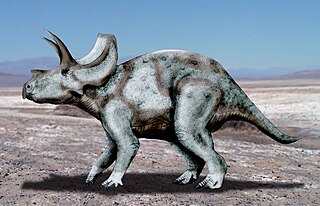
Ojoceratops is a genus of ceratopsian dinosaur which lived in what is now New Mexico, United States. Ojoceratops fossils have been recovered from strata of the Ojo Alamo Formation, dating to the late Cretaceous period. The type species is Ojoceratops fowleri.

Hippodraco is a genus of iguanodontian ornithopod dinosaur from the Early Cretaceous Cedar Mountain Formation of Utah, United States. The genus contains a single species, H. scutodens, known from a partial skeleton belonging to an immature individual.

Geminiraptor is a genus of troodontid theropod dinosaur that lived in North America during the Early Cretaceous period. Geminiraptor was a small, ground-dwelling bipedal carnivorous paravian. The type species of Geminiraptor is G. suarezarum.
Ambiortiformes is a group of prehistoric ornithuromorphs.















